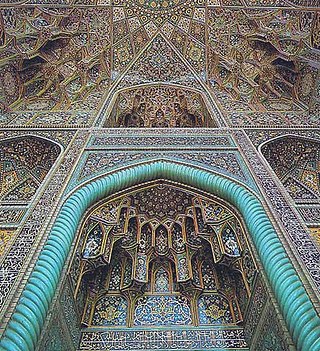The Barlas were a Mongol and later Turkicized nomadic confederation in Central Asia. With military roots in one of the regiments of the original Mongol army, the Barlas spawned two major imperial dynasties in Asia: the Timurid Empire in Central Asia and Persia; and its later branch, the Mughal Empire in the Indian subcontinent.

The Battle of Ankara or Angora was fought on 20 July 1402 at the Çubuk plain near Ankara, between the forces of the Ottoman Sultan Bayezid I and the Emir of the Timurid Empire, Timur. The battle was a major victory for Timur, and it led to the Ottoman Interregnum.

The Timurid dynasty, self-designated as Gurkani, was a culturally Persianate Sunni Muslim dynasty or clan of Turco-Mongol origin descended from the warlord Timur. The word "Gurkani" derives from "Gurkan", a Persianized form of the Mongolian word "Kuragan" meaning "son-in-law". This was an honorific title used by the dynasty as the Timurids were in-laws of the line of Genghis Khan, founder of the Mongol Empire, as Timur had married Saray Mulk Khanum, a direct descendant of Genghis Khan. Members of the Timurid dynasty signaled the Timurid Renaissance, and they were strongly influenced by Persian culture and established two significant empires in history, the Timurid Empire (1370–1507) based in Persia and Central Asia, and the Mughal Empire (1526–1857) based in the Indian subcontinent.

The Mughal emperors were the supreme heads of state of the Mughal Empire on the Indian subcontinent, mainly corresponding to the modern countries of India, Pakistan, Afghanistan and Bangladesh. The Mughal rulers styled themselves as Badshah or Shahanshah, a title usually translated from Persian as "emperor". They began to rule parts of India from 1526, and by 1707 ruled most of the sub-continent. After that they declined rapidly, but nominally ruled territories until the Indian Rebellion of 1857.

The Timurid Empire, self-designated as Gurkani, was a late medieval, culturally Persianate, Turco-Mongol empire that dominated Greater Iran in the early 15th century, comprising modern-day Iran, Iraq, Afghanistan, much of Central Asia, the South Caucasus, as well as most of contemporary Pakistan and parts of contemporary North India and Turkey.

The Qara Qoyunlu or Kara Koyunlu, also known as the Black Sheep Turkomans, were a culturally Persianate, Muslim Turkoman monarchy that ruled over the territory comprising present-day Azerbaijan, Georgia, Armenia, northwestern Iran, eastern Turkey, and northeastern Iraq from about 1374 to 1468.

The Registan was the heart of the ancient city of Samarkand of the Timurid Empire, now in Uzbekistan. The name Rēgistan (ریگستان) means "sandy place" or "desert" in Persian.
Timurid refers to those descended from Timur (Tamerlane), a 14th-century conqueror:

Shah Rukh or Shahrukh Mirza was the ruler of the Timurid Empire between 1405 and 1447.

Sultan Husayn Bayqara Mirza was the Timurid ruler of Herat from 1469 until May 4, 1506, with a brief interruption in 1470.

Gawhar Shad was the chief consort of Shah Rukh, the emperor of the Timurid Empire.

The Mausoleum of Khawaja Ahmed Yasawi is a mausoleum in the city of Turkestan, in southern Kazakhstan. The structure was commissioned in 1389 by Timur, who ruled the area as part of the expansive Timurid Empire, to replace a smaller 12th-century mausoleum of the famous Turkic poet and Sufi mystic, Khoja Ahmed Yasawi (1093–1166). However, construction was halted with the death of Timur in 1405.

Muhammad ibn Khvandshah ibn Mahmud, more commonly known as Mirkhvand, was a Persian historian active during the reign of the Timurid ruler Sultan Husayn Bayqara. He is principally known for his universal history, the Rawżat aṣ-ṣafāʾ, which he wrote under the patronage of the high-ranking functionary Ali-Shir Nava'i. According to the German orientalist Bertold Spuler, the Rawżat aṣ-ṣafāʾ is the greatest universal history in Persian regarding the Islamic world.

Architecture of Central Asia refers to the architectural styles of the numerous societies that have occupied Central Asia throughout history. These styles include Timurid architecture of the 14th and 15th centuries, Islamic-influenced Persian architecture and 20th century Soviet Modernism. Central Asia is an area that encompasses land from the Xinjiang Province of China in the East to the Caspian Sea in the West. The region is made up of the countries of Kazakhstan, Uzbekistan, Tajikistan, Kyrgyzstan, and Turkmenistan. The influence of Timurid Architecture can be recognised in numerous sites in Kazakhstan and Uzbekistan, whilst the influence of Persian Architecture is seen frequently in Uzbekistan and in some examples in Turkmenistan. Examples of Soviet Architecture can be found in Uzbekistan, Kazakhstan, Tajikistan and Kyrgyzstan.
This is a simplified family tree of the Timurid dynasty. The Timurid dynasty was a ruling house descended from the Central Asian conqueror Timur, who founded the Timurid Empire in 1370. At its peak, the empire encompassed Iran and much of Central Asia, as well as portions of modern-day India, Pakistan, Syria and Turkey. Following its fall in the early 16th century, Timur's great-great-great grandson Babur established the Mughal Empire in South Asia, becoming the first Mughal emperor. His descendants eventually came to rule most of the Indian subcontinent.
Abul-Qasim Babur Mirza, was a Timurid ruler in Khurasan (1449–1457). He was the son of Ghiyath-ud-din Baysunghur ibn Shah Rukh Mirza, and thus a great-grandson of Amir Timur.

The Marashiyan or Marashis were an Iranian Sayyid Twelver Shiʿite dynasty of Mazandarani origin, ruling in Mazandaran from 1359 to 1596. The dynasty was founded by Mir-i Buzurg, a Sayyid native to Dabudasht. Their capitals were Amol, Sari, and Vatashan.
The Timurid wars of succession are a set of three wars of succession in Central Asia waged between princes of the Timurid Empire during the 15th century and early 16th century following deaths of important monarchs.

The Timurid Renaissance was a historical period in Asian and Islamic history spanning the late 14th, the 15th, and the early 16th centuries. Following the gradual downturn of the Islamic Golden Age, the Timurid Empire, based in Central Asia ruled by the Timurid dynasty, witnessed the revival of arts and sciences. Its movement spread across the Muslim world. The French word renaissance means "rebirth", and defines a period as one of cultural revival. The use of the term for the description of this period has raised reservations among scholars, some of whom see it as a swan song of Timurid culture.

Timurid art is a style of art originating during the rule of the Timurid Empire (1370-1507) which had Turkic-Mongol roots and was spread across Iran and Central Asia. Timurid art was noted for its usage of both Persian and Chinese styles, as well as for taking influence from the art of other civilizations in Central Asia. Scholars regard this time period as an age of cultural and artistic excellence. After the decline of the Timurid Empire, the art of the civilization continued to influence other cultures in West and Central Asia.















